Hong Kong is one of the last places in the world where bamboo is still widely used for scaffolding in construction. It’s flexible, strong and cheaper than metal alternatives that are now more commonly used around the world. In Hong Kong, skilled armies of scaffolders can erect enough bamboo to engulf a building in a day – even hours – using techniques that are thousands of years old, and have been passed down through generations.
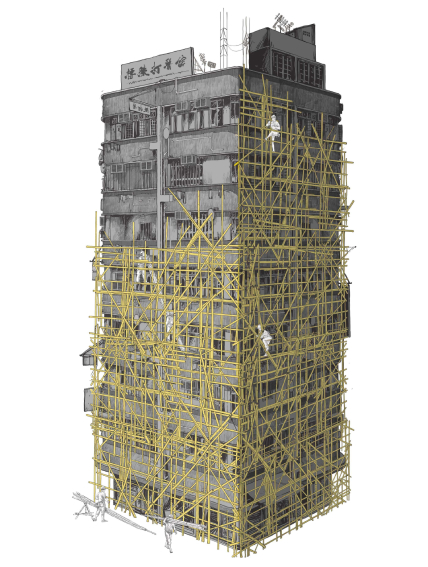 Bamboo’s internal cell-like structure allows it to withstand compression, making it an ideal material for scaffolding. Compared to steel, bamboo is much lighter, six times faster to erect and 12 times faster to dismantle. Bamboo scaffolding doesn’t require sophisticated machinery or complex tools to erect, just skilled workers with nylon ties.
Bamboo’s internal cell-like structure allows it to withstand compression, making it an ideal material for scaffolding. Compared to steel, bamboo is much lighter, six times faster to erect and 12 times faster to dismantle. Bamboo scaffolding doesn’t require sophisticated machinery or complex tools to erect, just skilled workers with nylon ties.
If properly erected, bamboo scaffolding can be stronger than steel and far more flexible. The resulting structure is also easy to modify, if necessary. In Hong Kong it is common to see “bamboo balconies” jutting from the sides of buildings where renovations are being carried out on individual units, many floors up.
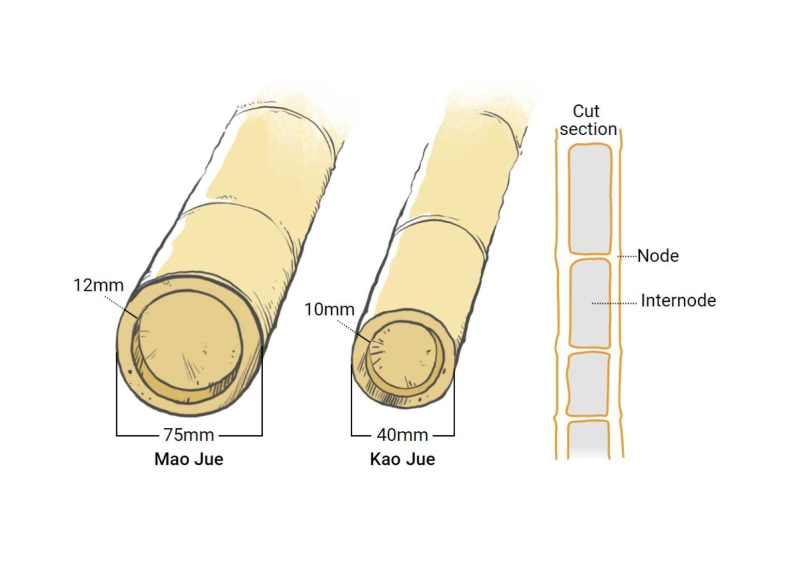 In Hong Kong, two types of bamboo are used in most scaffolding: Kao Jue (pole bamboo) and Mao Jue (hair bamboo). Mao Jue is thicker and stronger and is used as the load-bearing support. Kao Jue is thinner and is used for platforms, bracing and horizontal support. All bamboo is at least three years old, and dried for at least three months. Each piece is about seven meters (33 ft.) long, can be stored in the open, and typically usable three times before it starts to bend, split and weaken.
In Hong Kong, two types of bamboo are used in most scaffolding: Kao Jue (pole bamboo) and Mao Jue (hair bamboo). Mao Jue is thicker and stronger and is used as the load-bearing support. Kao Jue is thinner and is used for platforms, bracing and horizontal support. All bamboo is at least three years old, and dried for at least three months. Each piece is about seven meters (33 ft.) long, can be stored in the open, and typically usable three times before it starts to bend, split and weaken.
The scaffolders are Hong Kong’s real-life spider-men, climbing dizzying heights with strength, skill and nerves of steel. But the future of the bamboo scaffolder business remains precarious, due partly to a lack of new blood as many turn to other construction areas such as bar bending. Today, there are 2,479 registered bamboo scaffolders in Hong Kong.
Requirements for safe, sturdy scaffolding:
- Bamboo scaffolding should be erected, altered and dismantled only by trained workers
- Erection of structures should start from the bottom level to the top, from interior to exterior
- Working platforms should be at least 40cm wide, free of loose debris, and not overloaded
- A protective screen of fire retardant material must be installed to confine falling objects
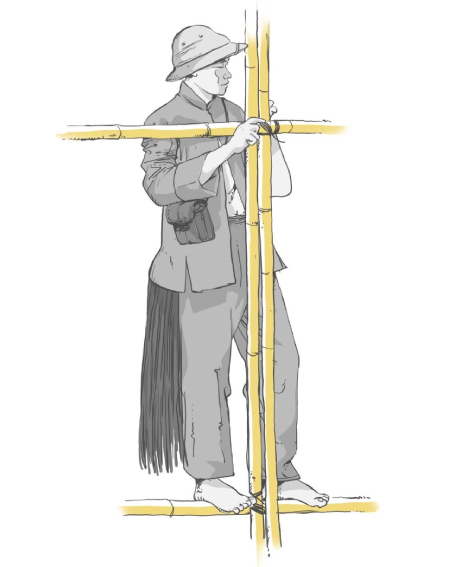 In the past, scaffolders would typically wear clothing for comfort and easier mobility – a straw hat for sun protection, a basic T-shirt, kung fu pants, a basic safety belt (if any), and sometimes, no shoes for easier climbing.
In the past, scaffolders would typically wear clothing for comfort and easier mobility – a straw hat for sun protection, a basic T-shirt, kung fu pants, a basic safety belt (if any), and sometimes, no shoes for easier climbing.
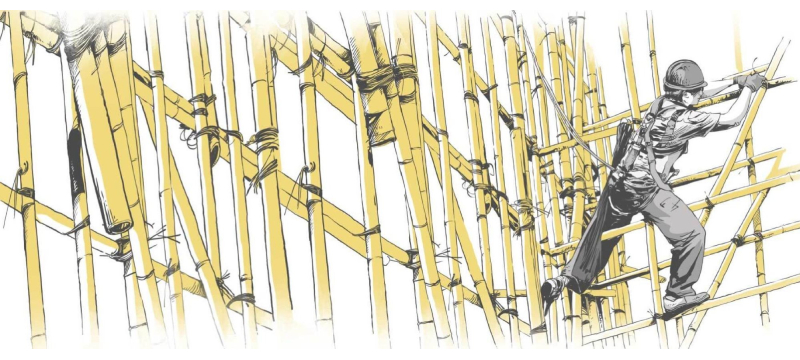 Now scaffolders normally use a full-body harnesses (which should be attached to anchorages), a hard hat, protective sleeves, gloves, and safety shoes. These days, a scaffolder’s belt carries a bundle of nylon strips, which are used to secure bamboo poles. Workers also carry a small bag with tools, including a knife.
Now scaffolders normally use a full-body harnesses (which should be attached to anchorages), a hard hat, protective sleeves, gloves, and safety shoes. These days, a scaffolder’s belt carries a bundle of nylon strips, which are used to secure bamboo poles. Workers also carry a small bag with tools, including a knife.
Many scaffolding skills have been passed down from masters to apprentices over hundreds of years. Today in Hong Kong, most new recruits must undergo year-long training with the Hong Kong Construction Industry Council for a license. Training involves learning how to build bamboo platforms that are safe and strong enough to hold construction workers on all different imaginable sites.
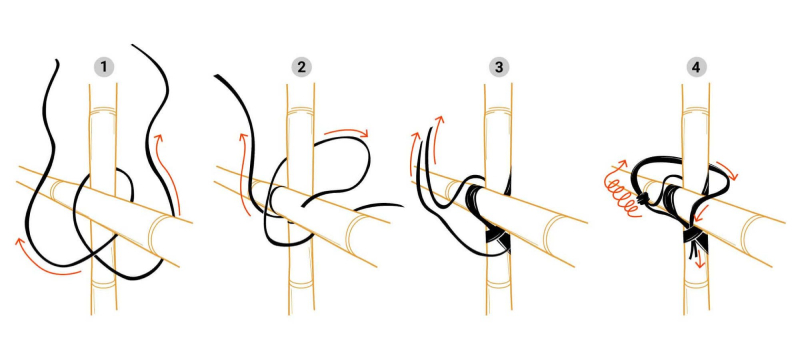 The toughest part of the job is tying a proper knot to secure bamboo poles, which can take years to master.
The toughest part of the job is tying a proper knot to secure bamboo poles, which can take years to master.
Workers are typically divided into three ranks. Those new to the industry are apprentices for two years. They have basic tasks, such as passing bamboo poles, while also learning the trade. Those in the middle rank erect bamboo scaffolding while being supervised by masters – the highest rank – who work with engineers to design entire structures.
Tradition calls for an apprentice scaffolder to discover if he is at risk of misfortune. If so, a feng shui master may recommend a ceremony to help cast out negative influences. Before work each morning, an apprentice should also be mindful about what he says so there are no bad omens for him and his workmates. Workers sometimes worship deities and wear a special belt that supposedly protects them from bad luck. It’s not uncommon for scaffolders to do a ceremony for good fortune before erecting scaffolding at new sites.
There are several types of bamboo scaffolding:
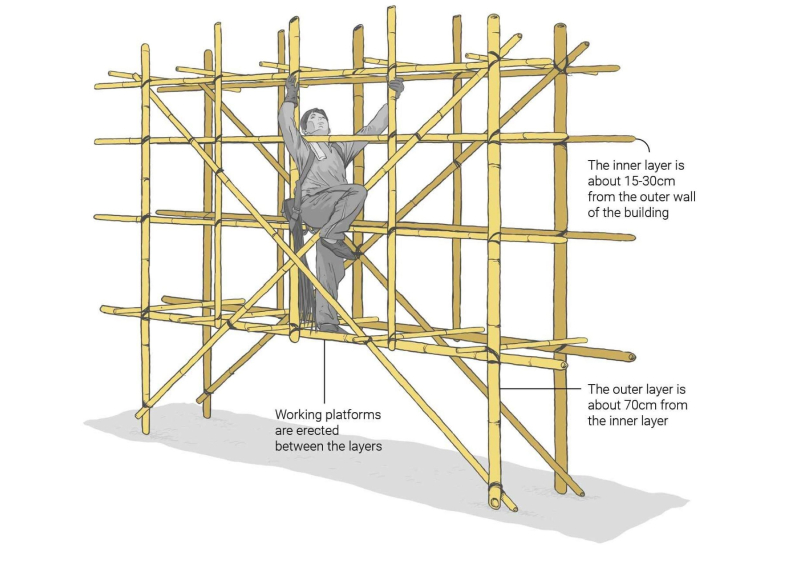 1. Double- or single-layered bamboo scaffolding is for building construction or major renovations.
1. Double- or single-layered bamboo scaffolding is for building construction or major renovations.
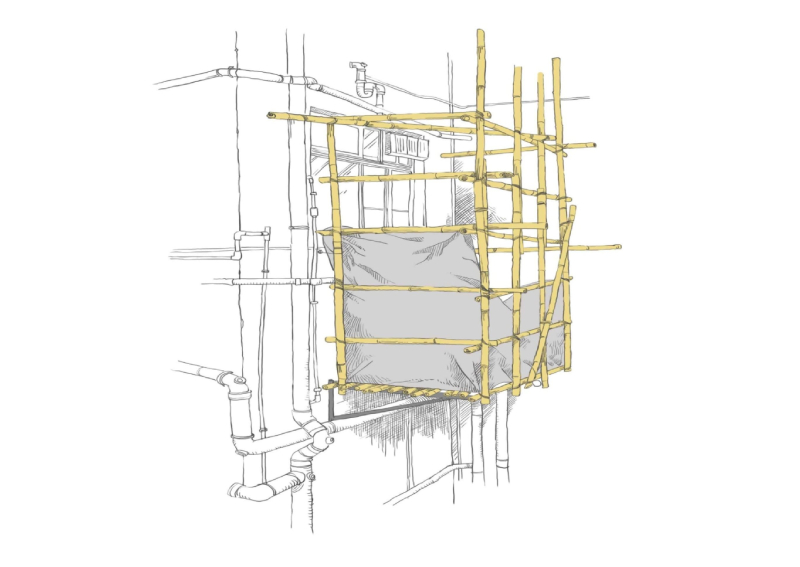 2. Truss-out bamboo scaffolding is often used as an exterior platform for minor repair work of external drain pipes, spalling concrete and external rendering. The height of the scaffolding should not exceed six meters.
2. Truss-out bamboo scaffolding is often used as an exterior platform for minor repair work of external drain pipes, spalling concrete and external rendering. The height of the scaffolding should not exceed six meters.
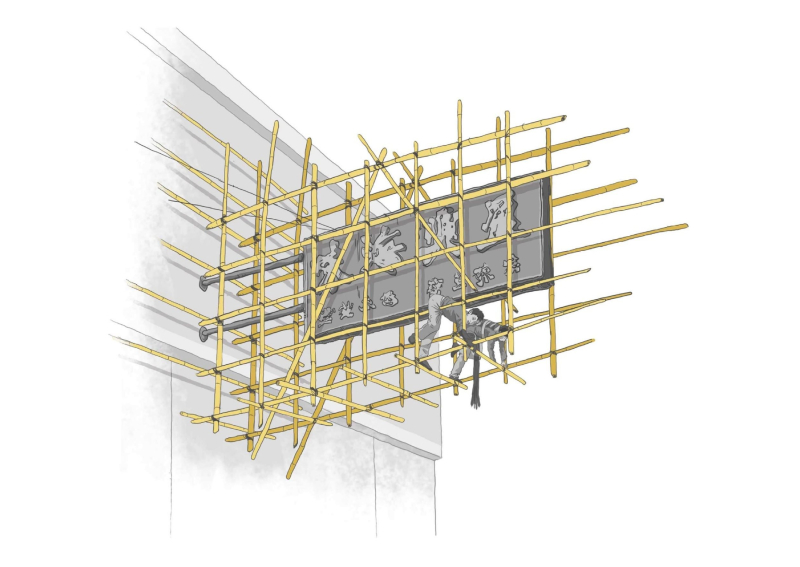 3. Bamboo scaffolding for signboards are typically of cantilever construction with a maximum 4:3 length-to-height ratio. The entire scaffold is supported by steel wires or hanging posts attached to the structural elements of a building.
3. Bamboo scaffolding for signboards are typically of cantilever construction with a maximum 4:3 length-to-height ratio. The entire scaffold is supported by steel wires or hanging posts attached to the structural elements of a building.
Regardless of type, bamboo scaffolding should be dismantled from the upper level to the lowest level, from the outside to the inside, and non-load-bearing parts before load-bearing parts.
You can read the original article at www.asiaone.com

I used to live in Hong Kong during the eighties and nineties. Originally the poles were tied with rattan rather than nylon. It was always amazing to see very tall buildings wrapped in bamboo scaffolding. It was also used by travelling theatre companies to build a complete theatre in a local car park.